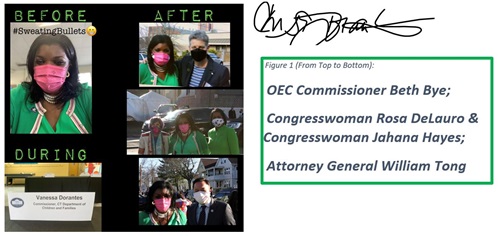Commissioner's Message
 Prevention - A Conversation with Vice President Kamala Harris
Prevention - A Conversation with Vice President Kamala Harris"I've been really looking forward to this," Vice President Kamala Harris said to me as we exchanged a socially distanced forearm bump. "We've been talking about you."
I was humbled, honored and of course - nervous to meet the Vice President of the United States. In preparing to take part in a 45-minute conversation with her along with Governor Ned Lamont, Senators Chris Murphy and Richard Blumenthal, Secretary of Education Dr. Miguel Cardona and my close colleague Commissioner Beth Bye from the Office of Early Childhood--- What would I wear? What should I say? What if I faint? 😊 As a life-long social worker, my passion has been shaped by the children, families, students, coworkers and stakeholders I have partnered with for almost 30 years…. I decided to bring all of those into this experience and JUST BE ME.
Sitting around at table at the Boys and Girls Club in New Haven, CT, we talked about Connecticut's children, the impact of the COVID-19 pandemic and the American Recovery Plan Act (ARPA) 2021. The Biden Administration's hope is that ARPA, in part, will lift at least ½ of America's children out of poverty. We would discuss this in the context of Connecticut's vision to prevent child abuse and neglect. https://www.c-span.org/video/?510319-1/vice-president-harris-listening-session-haven-connecticut
Children are best nurtured by supporting their parents and families are best uplifted by resourcing communities.
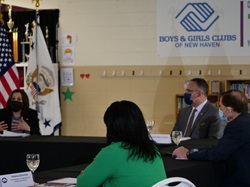 It is their strength and resilience which has motivated me each day; determined to empower and advocate for them. Here I was, speaking on their behalf, elevating their collective voice and telling their stories to the Vice President of the United States.
It is their strength and resilience which has motivated me each day; determined to empower and advocate for them. Here I was, speaking on their behalf, elevating their collective voice and telling their stories to the Vice President of the United States. The conversation was simultaneously awe-inspiring and comfortable, and I caught myself mesmerized that VPOTUS was actually taking notes! Little did she know that my words were the representation of a workforce who, even in a pandemic, show-up for CT families every day….
What else did I tell the Vice President about Connecticut's children and families? What structural, societal and individual factors impact our vision for their future? Read on…………
Shift to Prevention
Nationally, child welfare agencies are shifting focus to child well-being while assessing safety. The State of Connecticut is finalizing our Family First Prevention Plan - a collaborative effort with the input from over 400 community partners including youth and parents with lived-experience. This is Connecticut's plan, designed to enhance the lives of all of CT's families - not just those who come to the attention of the DCF.
Impact of Poverty
I emphasized that poverty and its insidious ripple effects, often masquerades in the child protective service reports we receive. Like every other jurisdiction in the country, Connecticut is not unique to this and we often find poverty hidden as a root cause of the crisis. COVID laid-bare for everyone to witness, what happens when limited resources are stretched so thin, they seem to evaporate.
We know that the vast majority of child protective services reports are categorized as neglect, not abuse. In 2018 and 2019, about 84% of all accepted reports involved at least one allegation of Neglect. This proportion increased in 2020 to 87.9%. During the same period of time, 25% of all accepted reports involved at least one allegation of Abuse (either Physical, Sexual or Emotional). This proportion dropped in 2020 to just over 21%.
When assessed, it is usually determined that the neglect allegations often times do not reflect child maltreatment but rather implications from poverty.
Listen to the Vice President talk about what she learned about the impact of poverty on Connecticut's children: https://www.wtnh.com/news/news-8-exclusive/exclusive-one-on-one-with-vice-president-kamala-harris-during-her-visit-to-connecticut/ Targeting child poverty IS the answer to this country's pandemic recovery.
Listen to the Vice President talk about what she learned about the impact of poverty on Connecticut's children: https://www.wtnh.com/news/news-8-exclusive/exclusive-one-on-one-with-vice-president-kamala-harris-during-her-visit-to-connecticut/ Targeting child poverty IS the answer to this country's pandemic recovery.
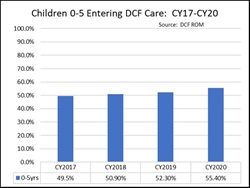 Our Youngest are the Most Vulnerable
Our Youngest are the Most VulnerableParental substance use, unstable housing and untreated mental illness all negatively impact parental capacity. The younger you are, the more vulnerable you are to the adverse circumstances around you.
This age group is consistently at risk in every jurisdiction across the country. According to the most recent Connecticut data, Children <1yr old make up a third of the total entries into foster care with children 0-5yrs old making up 55% of the total entries into foster care last calendar year.
I was able to share that although Connecticut is below the national average, the typical entry rate into foster care is of 1.78 per 1,000 children. For children <1yr old, this rate is 11.47 per 1,000.
Disproportionality and Disparate Outcomes
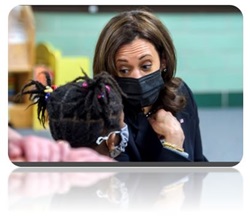
We could not talk about child well-being without talking about outcomes for all children. Children of color are reported more often to child protective services, their parents are substantiated more often (with no empirical evidence that their children are victimized more), they are more likely removed from their families of origin and are in care longer. By employing anti-racist strategies at the institutional level, we can change that trajectory.
In Connecticut, the entry rate into foster care is 3.50 per 1,000 for Black children, 2.28 per 1,000 for Hispanic and 1.21 for White children.
I highlighted for VP Harris that her historic FIRSTs are not lost on me. As a sit in this role, too as a 'first' African American DCF's commissioner, not only am I accountable to equitable outcomes -- this is a responsibility of us all.
Upstream Approach of Support not merely Surveillance
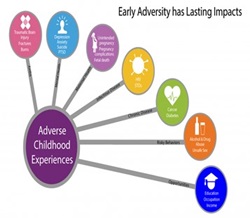 The pandemic exacerbated stressors within families and communities resulting in prolonged toxic stress and generalized isolation of children. As families struggled to survive the uncertainty, the conditions are certainly ripe for the development of Adverse Childhood Experiences (ACES) …. ACES are preventable. (2nd graphic)
The pandemic exacerbated stressors within families and communities resulting in prolonged toxic stress and generalized isolation of children. As families struggled to survive the uncertainty, the conditions are certainly ripe for the development of Adverse Childhood Experiences (ACES) …. ACES are preventable. (2nd graphic) Our work as an Agency is evolving with a vision shifting from a system solely focused on child protection, to a collaborative child wellbeing system which places priority on prevention and early intervention.
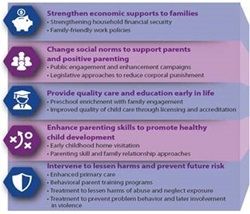 We believe families need local support not government "gotcha".
We believe families need local support not government "gotcha".Connecticut has reimagined its system to develop supports for families upstream with the goal of families being diverted from involvement with the child welfare agency while receiving supports right in their own community.
 Collaboration - A Value of Governor Lamont's Administration
Collaboration - A Value of Governor Lamont's AdministrationWe were proud to underscore that it is an expected imperative that Executive branch agencies work together to support parents to raise resilient children who can thrive in CT 's communities. All of our sister state agencies are necessary on the continuum to strengthen families. Collaboration and partnership are key to social-emotional learning and academic excellence.
****
I will remember this candidly honest conversation with Vice President Kamala Harris for the rest of my life.
It is my hope all children across the country will benefit from the Administration's vision of taking a bold approach to address child poverty head-on. I left the roundtable beaming with pride to benefit from the leadership of Governor Ned Lamont, the supportive resources fought for by the CT Congressional delegation, collaborative efforts across the 3 branches, our provider network, community partner organizations and THE BEST CHILD WELFARE jurisdiction in AMERICA!
